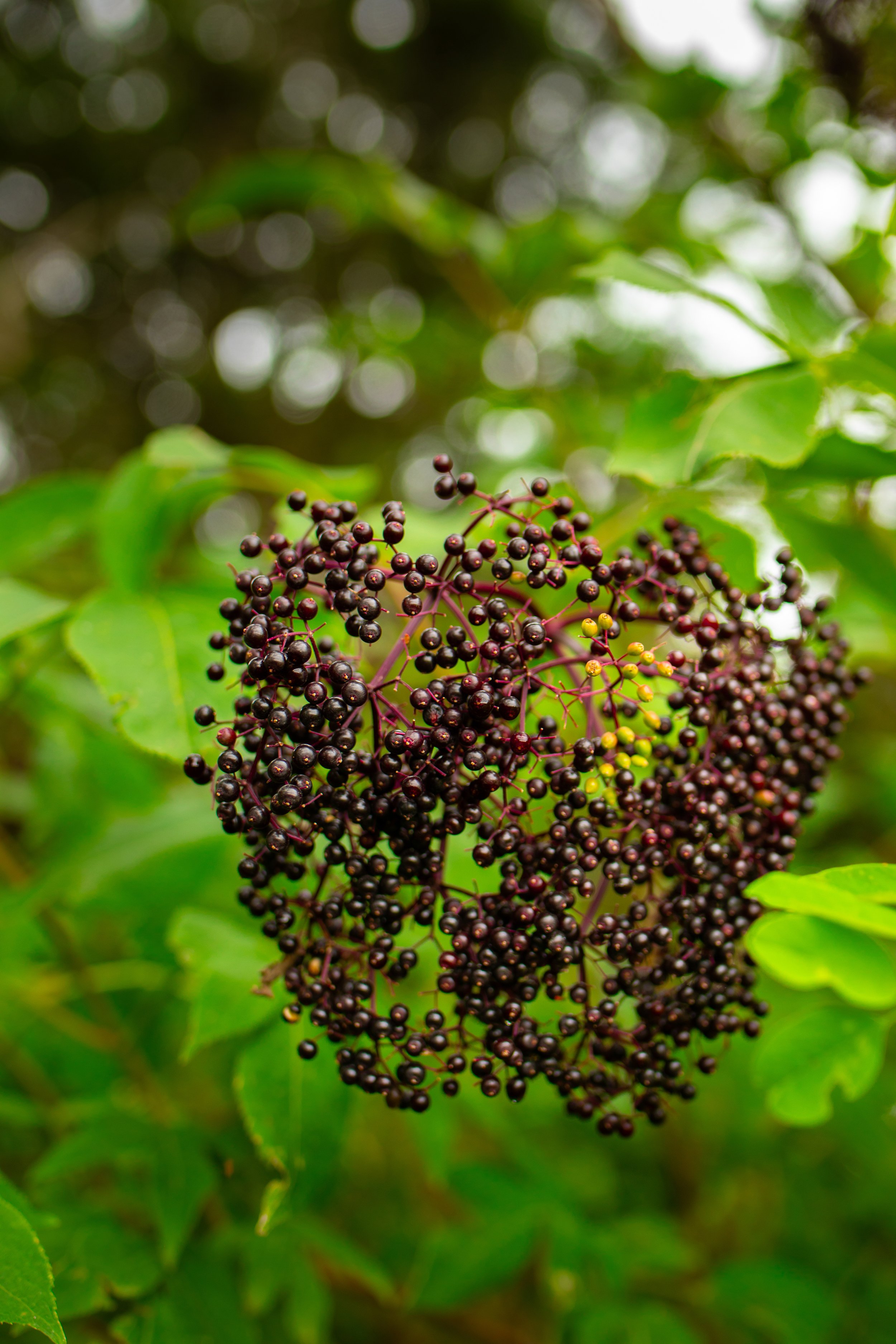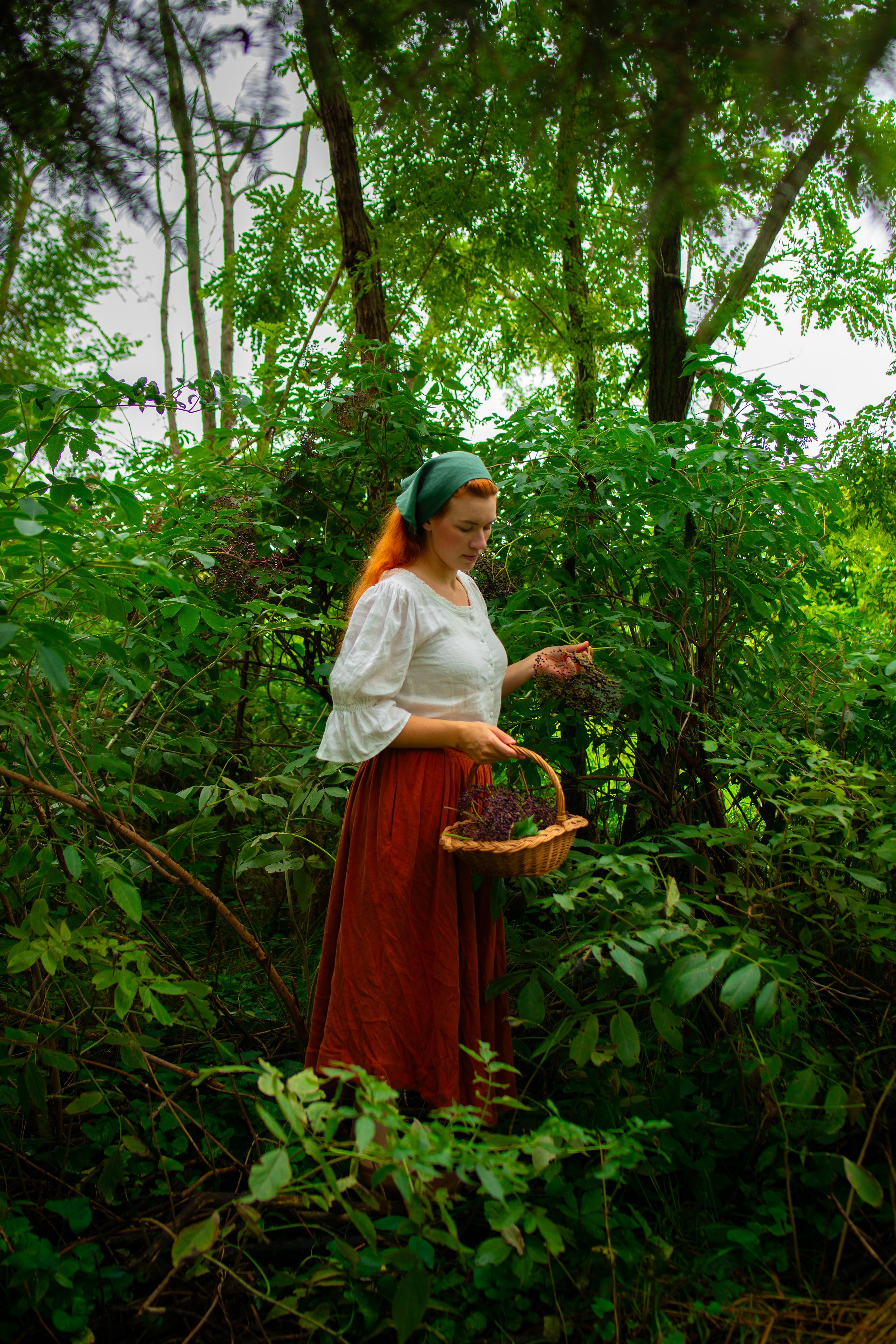The Ultimate Cozy Guide to Foraging for Elderberries
This post may contain affiliate links, please see our privacy policy for more information.
Have you wandered near the woods or river banks in the the late summer or early autumn months and discovered a tall bush covered in dark purple-black berries? You may have encountered an Elder tree! The elderberry, or Sambucus, is a wonderful edible plant that has many health benefits. Learn how to forage for elderberries this fall with this easy-to-use guide! Learn where to find elderberries, how to harvest them, wash them, and prepare them for storage all winter long.
what are elderberries?
Elder trees, or Sambucus, are deciduous trees or shrubs that have about 10 species. They belong to the Adoxaceae family. They grow in various parts of the world including both the Northern and Southern hemispheres. They are a wonderful addition to forests and woodlands as their flowers provide nectar for pollinators and their berries provide food for various wildlife as well as humans.
The most commonly found elderberry plant in the United States is the American Black Elderberry. Generally, they flower from June to July, and the fruit is ripe and ready to pick August through September.
are elderberries good for you?
It is becoming more and more common for people to be aware of the benefits of elderberries for their health. The berries are commonly used in various medicines including cough syrup. The elderflowers, which bloom in mid to late spring, are also wonderfully beneficial for your health!
High in Nutrients. Elderberries are packed with beneficial nutrients to human health. It is said that 1 cup of elderberries contains 97 percent of the recommended daily amount of vitamin A! They are a wonderful source of potassium, fiber, and antioxidants - up to 10 times the amount found in other berries.
Help with Cold and Flu Symptoms. One of the most common uses for elderberries in holistic medicine practices is for relief with cold and flu. Elderberries have been used for thousands of years, including in Ancient Egyptian and Native American medicinal practices. You will often find elderberry in commercial products for these illnesses such as throat lozenges, cough syrup, gummies, pills, and teas. However, there are limited studies on if elderberry really does help to relieve these symptoms. If you are trying to avoid catching a cold, it can be a good idea to take a tablespoon of elderberry syrup during the sick seasons as a preventatitve!
Reduces Blood Pressure and Blood Sugar. There have been a few studies, mostly on animals, that showcase elderberry has been effective in reducing cholesterol, blood pressure, and blood sugar.
Please take any holistic medicine or herbal foraging advice with a grain of salt. I am not a trained herbalist and am only sharing my experiences as a hobbyist and Master Gardener. Always consult with your practitioner before working with foraged plants that you are not knowledgable on.
elderberries in folklore:
The elder tree has a long history in folklore! If you are a fan of high fantasy stories, the elder tree is often mentioned as being the base for various magical objects. The most commonly known elder tree is the Sambucus nigra, the European elder or Black elder. This species is native to Europe, parts of Asia, and North Africa. It’s no wonder why the elder tree is mentioned so often in European folklore!
The name elder comes from the Angelo-Saxon word, “aeld” which means, “to kindle” or “fire.” The elder tree was given this name because of its hollow stems, which were used to blow on kindling to start fires.
The elder tree was believed to house spirits or other supernatural beings and was referred to as “Queen of the Woods” or “Elder Mother.” These elder spirits could either bring blessings or curses, depending on who came across their branches. Elderflower blossoms, in particular, where considered auspicious and were used in wedding ceremonies. Their sweet, fruity fragrance was thought to ward off evil from homes and bring good luck.
where to find elderflowers:
There are several different species of the elder tree. For this post, we will be focusing on identifying the Sambucus canadensis, or the American Black Elderberry as this grows where I live.
The American Black Elderberry is also known as the Common Elderberry, American Elder, or simply as Elderberry. It is a 5 to 12 foot (1.5 to 3.6 m) deciduous shrub that is native to North American, Venezuela, and Brazil. American elderberry can be found all throughout the state of Iowa and usually is found growing along roadsides, usually on country roads. This is where I have often found elderflowers to forage before I found them growing on my property!
In general, American elderberry prefers rich, moist, and slightly acidic soil. This is true of most berries that are rich in anti-oxidants like blueberries and aronia berries. They can grow in partial shade and full sun and will spread by root suckers, which can eventually grow into thickets.
Indentifying elderberries:
To help you identify the American elder, here are some quick identification hints to look for:
Deciduous shrub or small tree with multiple stems from the base. It measures 5 to 12 feet (1.5 to 3.6 m) tall and 6 to 10 feet (1.8 to 3 m) wide. In general, they are wider than they are tall.
The bark is grey-brown to yellow-gray with a white pith.
It has pinnately compound leaves with 5 to 11 leaflets, and the leaves are 2 to 6-inches (5 to 15-cm) long and 0.5 to 2.5-inches (1 to 6-cm) wide. They have a serrated margin and toothed leaflets.
They have profuse blooms of creamy-white flowers that have dozens of tiny flower heads on them. The flowers are fragrant and sweet, similar to pears or honey. They are flat-topped and grow in rounded clusters called umbels.
Once the umbels begin to fruit, they will be covered in dozens of little hard green berries. The berries will begin to ripen, turning a light pink to deep red to an almost black purple color. The berries are usually ripe in the late summer to early autumn months, generally around late August to mid September depending on where you live.
BE CAUTIOUS. When foraging, it is always best to use caution and study your plant before consuming. The leaves, stems, bark, and roots of elder bushes are toxic. Only consume the flowers and berries.
how to harvest elderberries:
Once you have identified your elderberries, now you must learn the best practices for harvesting them! As I have said in my other foraging and harvesting posts, it is not about how much you can gather and preserve, but rather about how you can enjoy the process of doing so.
DO NOT CONSUME RAW ELDERBERRIES! Raw elderberries as well as the leaves, stems, roots, and stalk are all poisonous. These uncooked parts of the plant contain a cyanogenic glycoside called sambunigrin, which can make you sick.
Bring a Basket or Mesh Bag. Using a compact container to collect elderberries is best, as some of the berries will fall off of the umbels as you pick them and transport them. This way, you can catch any berries that have fallen. Proper air circulation can also be crucial to preventing the berries from starting to rot once picked.
Remove by Hand. I have found that it works best to harvest your elderberries by hand. They are rather delicate and squish easily. Shaking them can be difficult as they are so small. Be aware that they do stain, so dress appropriately and wear gloves if you are wary of having your hands stained. The juice stains do wash away from skin fairly easily, in my experience!
Remove the Stems. It is easiest to remove the entire stem of berries rather than picking off individual berries. This can help prevent berry loss, staining, and squishing of the berries. Simply place the entire umbel with berries into your basket.
Pick Clusters that are 3/4 or more Ripe. The green berries are not edible and will not continue to ripen after being picked, so you will want to focus on clusters of berries that are nearly all ripened. You can tell when the berries are ripe by the dark purple-black color and the squishiness. If the berries are still hard, they are not yet ripened.
how to store and preserve elderberries:
After picking your elderberries, try to process them as soon as possible. The berries do not store well at room temperature, but they do store for a decent amount of time (about 5 to 7 days) in the refrigerator. However you will want to remove them from the stems as the stems are not edible, and neither are the raw berries.
One of the easiest ways to remove the berries from the stems is to freeze the stems and berries while still in tact. Place the entire berry cluster onto a cookie sheet and pop it into your freezer. Once fully frozen, gently pull the berries off the stems and place them into a freezer safe storage container or set them aside to cook with. This will help prevent the berries’ skins from tearing.
If you do not want to do this, simply begin pulling off berries as gently as possible and placing them into a bowl or container while you work. Then, wash the berries in a large bowl and strain.
At this point, the elderberries can either be frozen or dried. To freeze the elderberries, simply place them into a freezer safe container, label, and date. They should keep for about 1 year or longer. To dry your elderberries, lay them on baking sheet and bake at 170° F (76° C) or lower and bake until they are no longer wet or juicy. You can also place them into a dehydrator, though they may fall through the holes in the tray!
baking & Cooking with elderberries:
Personally, I love using elderberries during their peak to make various recipes and preserves in my kitchen! There are so many delightful and unique recipes that you can make, both with dried and fresh elderberries.
To use fresh elderflowers, try to remove as much of the stem, or umbels, as possible. It is best to NOT wash them, as this can damage the flowers and alter their flavor. Simply shake out any insects that may be living on the flowers.
Fresh, frozen, or dried elderberries can be used to make a number of different dishes such as quick breads, cakes, pies, syrups, sauces, cordial, and so many others. Here are some elderberry recipes from my blog:
Elderberry Cordial
Spiced Elderberry Syrup
final thoughts:
I hope that you enjoyed this easy guide to foraging for elderberries!
Elderflowers and elderberries are full of extraordinary medicinal benefits. I also love learning about plant folklore, especially when I am foraging for unique ingredients. While its no longer common to gather elderflowers for use in the home, I think it is something that can be so wonderful to incorporate in a small way to connect with the people from the past who used to do the same.
This cozy guide is meant to help take the pressure off of gathering and preserving wild foods, and I truly believe that even just gathering a few elderflower sprays for one small cup of tea is just as grand as storing enough to last you for the entire winter.
xoxo Kayla
more posts you might enjoy!
sources:
Elder; Woodland Trust
American Black Elderberry; U.S. Forest Service
What to know about elderberries; Ohio State University
Elderberry; University of Rochester Medical Center
Elderberry in the Garden and in the Kitchen; PennState University Extension
How to Grow Elderberry in Your Garden; Utah State University Extension















